- This page is about the mod called Rift. For other uses, see Rift.
| Rift Modloader | |
|---|---|
| Current developers | Runemoro, Chocohead |
| Version | 66 |
| URL | Link |
Rift is a lightweight modding API and loader for Minecraft: Java Edition. Rift's first snapshot was released on July 6, 2018.[1] It has had development from 1.13 to 1.13.2 but since Fabric and other matters have come about.
Rift has been abandoned or had large gaps of infrequent support by developers during 2019 & 2020. The most recent mods made for Rift was Watson and StaffDerpsMod on March 29th 2020, even Ears on November 11th 2020 and Pistorder on December 23rd 2020, but most mods have been since ported to Fabric (Rift's successor) or remained on Rift.
Background/General Information[]
According to a changelog under the Rift 1.0.0 SNAPSHOT on July 6, 2018, it is stated that it works with Pre-Release 5 of 1.13 Minecraft Java Edition snapshot, making it not only the start of 1.13 modding support, but a continuation of snapshot modding since Meddle back in 1.11 (Forge wasn't available for 1.13 versions at that time and Forge isn't known for supporting snapshots although mods can support snapshots if a mod developer has made this possible).
Rift is only available for Release 1.13 and 1.13.2 on CurseForge through a 1.13.2 snapshot by Chocohead (known contributor for the Rift project around 1.13.2 support besides Runemoro's release of a 1.13.2 Rift on January 1, 2018 being 1.0.4-106 only available on Github) and via Github.[citation needed]
But the later versions of Rift releases after the Rift 1.0.0 snapshot and 1.13 snapshot period, since followed for Release 1.13 as of July 23, 2018 & 1.13.2 with assistance by Chocohead on December 2, 2018 and as later releases came about support for 1.13 slowed down on Curseforge and latter access to the modloader updates have since been only available via GitHub with releasing around September 3, 2018 version 1.0.4-72 to even so recent as January 1, 2019 with version 1.0.4-105 for 1.13, and 1.0.4-106 for 1.13.2.
After 1.13 releases were not appearing likely, continuation of the project has since been available to 1.13.2 with the assistance of Chocohead but Runemoro has released a 1.13.2 version on GitHub since January 1, 2019, that being version 1.0.4-106, but most will acknowledge Chocohead as the contributor of 1.13.2 due to the 1.13.2 Rift Snapshots for download on Curseforge from mods such as Aquarius and VoxelMap being the two noticeable releasing 1.13.2 Rift supported versions since December 2, 2018 exactly.
Due to lacking releases of Rift on Curseforge, certain mods like PGEG (Pretty Game Enhancing Gobblet) state they use Rift versions higher than 1.0.4-66 available on it's Curseforge mod page, a link to the GitHub page for Rift releases was available for a brief time on the same page PGEG is the source of on Curseforge but has since been removed as of an unknown date (same link on GitHub is the one as the source listed to the right 'source available'). [citation needed]
Many mods that have been supported from Liteloader like VoxelMap to others commonly on Forge had been ported to Rift but have now moved to Fabric, making up a small minority of mods appearing available for the modloader throughout 2018 and 2019, or Fabric's much brief exist in 2018 and 2019 which more developers were jumping to from Forge for the 1.14 snapshot 18w49a and 18w50a as of acknowledged snapshots able to run Fabric in favour compared to Rift. [2]
Rift's intentions as a modloader have been explained on the Curseforge page by Runemoro stating "The main object of Rift is to make a more modular and lightweight modding API for Minecraft Java Edition. Rift is not intended to compete with or replace Forge, but rather Rift and a set of optional community-made library mods is". [citation needed]
Rift has varying differences to Forge but similarities to Fabric Modloader for features players/users will notice. Rift has mods such as 'Rift Mod List' a mod that lists the mods for it compared to Forge having a 'Mod Options' button that users can use to view mods loaded, open the mods folder and access configs (which very few mods have configs for with Rift versions).
Rift by default once installed allows users to view Rift mods in 2 ways, either by using the '/datapack list' command using the Minecraft command system (for mods that use or state they are datapacks due to the mods supporting Datapacks), or viewing them with the Resource packs menu, but Rift mods aren't actually in the Resource packs folder however for this to happen, they must be in the Mods folder of the .minecraft instance the user has installed Rift to.
Known Installation Methods Of Rift[]
Rift has a variety of ways and launchers it can be installed to, 2 are currently well known due to the tutorials that currently exist, the two methods are the Minecraft launcher and MultiMC5. No true 'official' method exists for the Twitch launcher (now Curseforge launcher).
Rift Supported Mods[]
This is a list of all currently available (on Curseforge & Github), abandoned, archived or unreachable mods for Rift on 1.13 & 1.13.2. More can be found on the Rift Discussion Thread or the Rift Mod Archive.
1.13[]
- Advanced Shulkerboxes
- Aether Legacy Rift Edition
- Almost Enough Items
- Aquarius
- Better Beacons
- Better Together
- Chat Bubbles
- CraftPresence
- CreeperWorks
- DeathMaps
- Dorsim
- Ears
- Ender Compass
- FoamFix
- Gamemode Fix
- Ghost Buster
- Gravestone
- Half Logs
- HaunchHUD
- Horse Debug Info
- Iron Chests For Rift
- LocaleFixer
- Matter Vortex
- MineAMP
- Mr Crayfish's Furniture Mod Rift Edition
- Neat For Rift
- Optifine
- Patty's More Tools 2
- Pretty Game Enhancing Gobblet (PGEG)
- Probe Data Provider API
- ProtoCharset
- RandomConfigs
- Reap
- Relocate
- Rift Mod List
- Rift Nether and End Ores
- Rift Corail Pillar
- Rift Corail Recycler
- Rift Mouse Tweaks
- Rift Wastelands
- Riftlin
- Roughly Enough Items (AEI successor)
- Shields Plus
- Sky Ores
- Snowflake
- StackUp
- Stockpile
- Tea and Biscuits
- TIS-3D
- VanillaDeathChest
- VoxelMap
- WATT: Waterlog All The Things
- WorldInfo
- Xray
- ZeroPoint Energy API
1.13.2[]
- Aether Legacy Rift Edition
- Autofish
- Aquarius
- Bedrock Break Helper
- Bounding Box Outline Reloaded
- Chat Bubbles
- CraftPresence
- Custom Selection Box Port
- Dynamic Lights Rift
- Ears
- EasierChests
- EasierCrafting
- EasierVillagerTrading
- Extra Player Render(ing)
- Finder Compass
- Flight Helper
- Giselbaer's Durability Viewer
- Grid
- Item Scroller
- Light Overlay
- Litematica
- MaLiLib
- MineAMP
- MiniHUD
- MobCountMod
- Neat For Rift
- NextSpring
- No PVP Cooldown
- Pistorder
- Optifine
- RandomConfigs
- Rift Mod List
- Scift
- Simple Light Overlay
- StaffDerps
- StepUp For Rift
- Syrup
- ThaiFixes
- Tweakeroo
- VanillaDeathChest
- VoxelMap
- Watson
- WorldInfo
Minecraft Java Edition Launcher Rift Installation Tutorial[]
Rift Minecraft Java Edition installation is accomplished similar to how a user may install Forge, Rift can be acquired from Curseforge or GitHub for the Modloader compared to Forge's centralised site as Rift isn't known for having one like Forge or Liteloader. Fabric however differs as it has a centralised wiki with download instructions for the modloader while the Fabric API and mods are located on Curseforge. [3]
Java 8 is required Before Installing Rift
Like with any modloader like Forge or Fabric, Rift requires Java 8 or Java 9, but specifically Java 8 updates from around the June 2018 period are required to be installed before using Rift. This is recommended for both Rift 1.13 & 1.13.2 versions.
1.Once a user acquires Rift from their download source of choice, they are able to double click the Rift.jar like they would with Forge installing into the Minecraft Launcher. From there it will give the user a response/feedback window stating the user has successfully installed Rift into the launcher.

Rift Modloader feedback message stating installation with the Minecraft Launcher with it completing a Rift 1.0.4-77 install.
2.After they have accepted the message's response, they can go to their Launcher to find either a profile created automatically or they need to create one themselves via the Launch Options tab, following up the creation of Rift's new profile/versions it has installed already, the user will have to create a new profile themselves using the Launch Options and selecting a Rift version for that profile if an automatic one is not created for them.

Rift Modded Automatic Profile Results after installation with the Minecraft Java Edition Launcher.
Note: Rift can create its own profile upon installing, but just like Forge it can if a profile is already created for that version it will not bother to create a one itself and act like it's updating that profile instead, or the user is able to update it themselves with the Launch Options tab and a version selection. But Forge seems to be more following this logic compared to Rift when using later/another version past 66 from testing (not accurate enough testing to go on), but for the sake of varied results it's best to say it's inaccurate information until proven.
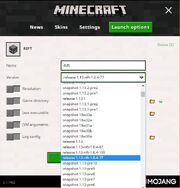
Rift being selected from the Launch Options tab. Its a good idea to do this to switch between Rift versions when updating Rift, or when checked Rift's installed properly, as well as setting up Rift themselves if Rift doesn't automatically create a profile for the user.
3.The user may be required if Rift does not automatically create a profile, for them to create a Rift one themselves and use the Launch Options tab and selecting a Rift versions that the 'versions' folder of the .minecraft instance recognises to get a Rift setup working.
4.After the user has a Rift setup completed with these considerations all they need is some mods in the mods folder to test.
Note: Like with Forge if the mods folder doesn't exist, it is best for the user to create one themselves in the .minecraft folder to put mods in.
Unlike Forge however, Rift will not understand mods in multiple folders. Forge can notice say a list of mods in 1.7.10 or 1.12.2 folders the user has create to separate them and allow for compatibility and less conflicts between what Forge is supposed to recognise, but Rift can't understand mods in any folders inside another folder.
For example if the directory is .minecraft/mods/1.12.2 Forge will only look for mods in the 1.12.2 folder.
Rift cannot notice mods in the 1.13 or 1.13.2 folders, only the mods folder. Fabric works similar, from 18w49a to 1.15 it has never been possible to put mods in deeper folders and doesn't seem like it will include that feature in the future. [citation or accuracy]
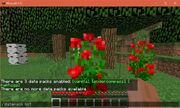
Rift mods listed using the /datapack list command (mods only appear like this if the developer has set it up). While it is recommended to use Rift Mod List, this is one of 3 ways to find out mods installed in a Rift instance.
[]
Users can use the /datapack list command in their chat/command line to find what Rift mods or datapacks are installed.
Rift mods that have datapack support is the reason why mods can be displayed as datapacks when viewing by the command. Otherwise Rift mods are visible by the Resource Packs menu.
This is a good idea if a user doesn't have the Rift Mod List mod installed and wants to find out what's loaded and what's not.
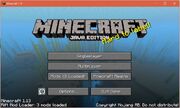
A 1.13 Rift instance, and the Rift Mod List mod used as evidence to state how many mods are loaded, as Rift by default doesn't have such a feature.
The Rift Mod List mod will allow, like mentioned before, to state the mods listed, and can have images presented next to the listing, but there is a odd occurrence with the list mod however.
When using Optifine '1.13.2' version E4 (as E5 results in crashes of unknown cause with Rift or Rift mods), Rift Modloader will not state how many mods are loaded and only the 'Minecraft 1.13' text will appear, once Optifine is removed however (the Optifine extraction where it's accessed in the mods folder instead of it's own profile) Rift Mod List is able to state how many mods are loaded without conflicts of Optifine.
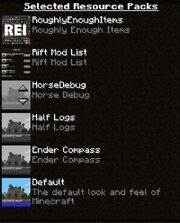
Rift Mods (setup by the developer to be displayed) visible from the Resource Packs Menu under selected. The user does not have to install a mod the same way as a Resource Pack for this to appear. If you don't have Rift Mod List installed this or the /datapack list command are useful ways to see what is installed.
MultiMC Installation Tutorial[]
1.There is two ways to install Rift for MultiMC. You the zip file, or the add empty method.

Showing how to import Rift zip file instances into MultiMC.
2.Zip File Method: To install Rift into MultiMC using a zip file, download it from curseforge or the Rift GitHub and store it locally, then import the zip file to create a new instance.
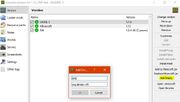
Showing where and how to add the "Add Empty" method details into MultiMC to install Rift for the launcher.
3.Add Empty Method: For the add empty method it requires a bit more to get setup. You'll want to refer to the Rift GitHub for this one.
4.To start this method create a new 1.13 or 1.13.2 instance, then select the 'edit instance' button.
5.To forward the installation process select the 'add empty' button and inputs for a 'name' and 'uid' will appear.
6.The 'name' should be 'Rift' while the 'uid' should be 'org.dimdev.rift'. Once that is setup you should select the 'edit' button and a text document will appear.
7.Remove this information and add the example code into the text document and save.
8.Once this is completed it is best to launch the instance to check if it was installed correctly.
OptiRift (Optifine Mod.jar Extraction + Rift Modloader Profiles) Tutorial[]
1.Optifine can be installed alongside Rift Modloader, but it depends if the user considers Rift Mod List (a separate mod that has a proper mod list compared to Rift's default features listed before) or not as one can tell from the description and image above of such results related to the two.
2.Optifine's installation alongside Rift is done by downloading Optifine how one would normally.
3.Then double clicking the downloaded Optifine.jar (Optifine E4 for 1.13.2 was used in this example) the user has the options to 'Install', 'Extract' or others on a window. The user will likely want to select the 'Extract' button so Optifine turns to a mod.jar file for the best results.
4.Once the user has done this, put the Optifine Mod.jar into the mods folder of their .minecraft instance (considering the Java Edition rather than other launchers for this explanation). 5.Once the user has made sure the Rift mods are also in the /mods folder, not the /mods/1.13 folder.
6.The user can start up their game and check the Video Settings part of the Options menu of your Launcher and Optifine settings will be available, making it clear that OptiFine should be installed successfully.
Note: When it comes to 1.13.2 Rift versions (of the two known at the time of writing this, it is unknown if the same issues happen with later 1.13.2 snapshots of Rift), the 106 version was released later than the SNAPSHOT 1.13.2 version (SNAPSHOT made in Dec 2018, the 106 version in Jan 2019) so anybody that uses Shaders is best to use the 106 version on GitHub rather than the SNAPSHOT version so there is no graphic issues with Optifine, Rift and Shaders.
Curseforge Launcher Unofficial Installation Tutorial (previously Twitch)[]
Installation of Rift on the Curseforge launcher requires installation of the modloader on the Mojang launcher before starting.
1.With Rift installed on the Mojang launcher, make your way to the 'versions' folder. The easiest way to do this is to locate the resourcepacks menu and selecting the left button in that menu. Once the button is selected, a folder will appear where the user can put resource packs. Go back up to the '.minecraft' folder and select the 'versions' folder.
2.Inside the versions folder, look for a Rift install (either 1.13 or 1.13.2) and copy the Rift install folder. For example: 1.13-rift-1.0.4-105, 1.13.2-rift-1.0.4-106 or 1.13.2-rift-1.0.4-SNAPSHOT.
3.With this on your clipboard, open the Twitch launcher and create a new profile. When creating a new profile, set the modloader option to none as without it, it will launch with Forge which will not allow Rift to run.
4.Let the profile get the necessary requirements and once it's complete, open the profile. Once open, go to the Cog/Gear icon in the top right of the profile and select 'Open Folder'.
5.With the folder open, go up two folders to the 'Install' folder. Paste the folder from step 2 into the Install folder. The .mixin.out folder may be necessary, so go back to the 'versions' folder from step 2 and copy/paste that into the 'Install' folder as well.
6.Once Rift's folder contents are in the correct places, download the mods through Twitch (now Curseforge launcher) or from Curseforge, put them into the mods folder (via 'Open Folder' and the mods folder of that profile) and launch the game.
7.Launch the launcher (close it if it was already open so it can display the Rift profile or allow selection of it) and go to the 'Installations' tab. From there, select the Rift version that was added to the 'Install' folder and run the game.
8.Make sure the necessary libraries are in the mods folder, or relaunch the launcher before attempting to run Rift. The thing users will notice about this Rift install is that the version will not stay selected, this is due to it not being a proper modloader option to select like the Forge one is. So it is recommended to check the version often when using Rift through the Curseforge launcher. There is no way around this, even Jumploader that adds Fabric support to the launcher doesn't work on Rift.
References[]
4. Rift Minecraft Java Edition/Vanilla launcher builds
